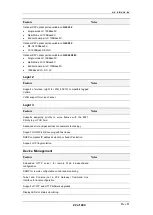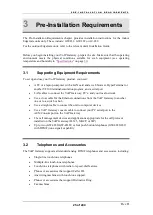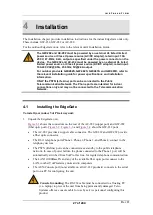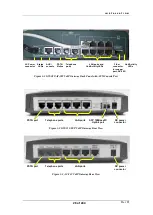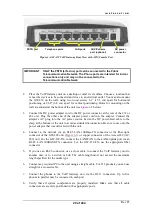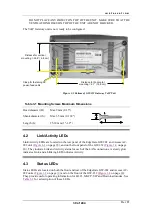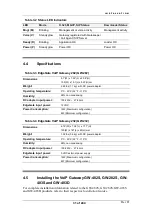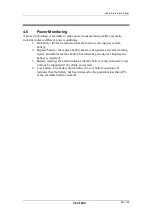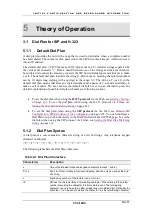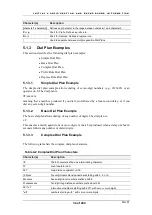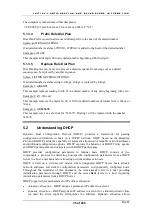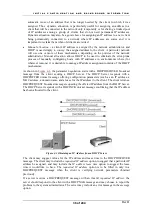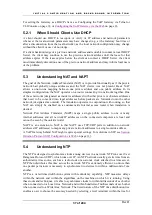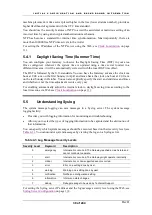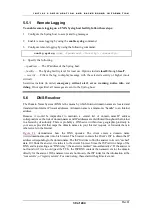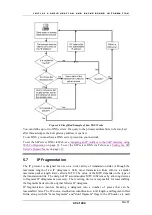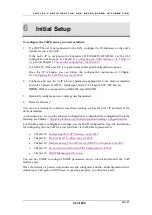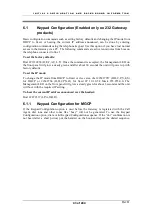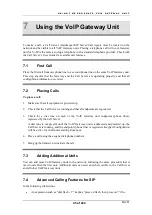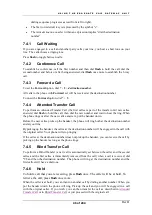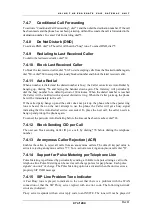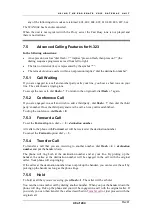
I N I T I A L C O N F I G U R A T I O N A N D B A C K G R O U N D I N F O R M A T I O N
Rev H
35 of 244
The complete syntax scheme of this dial plan is:
(>#|0T|00T|[3-5]xxx|8xxxxxxx|91xxxxxxxxxx|9011x.T|*x.T)
5.1.3.4
Prefix Rule Dial Plan
Dial Plan Prefix is used to add a user defined prefix to the head of the dialed number.
Syntax:
p
(STRING1)STRING2
If a dialed number matches
STRING1
,
STRING2
is added to the head of the dialed number.
Example: p(2x.t)00
This example adds digits 00 to any dialed number beginning with the digit 2.
5.1.3.5
Replace Rule Dial Plan
Dial Plan Replace can be used to prevent a dialed sequence from being sent or a dialed
sequence can be replaced by another sequence.
Syntax:
r(
STRING
,
STRING2
)
STRING3.
If a dialed number matches string2, string1 is replaced by string3.
Example 1:
r(0,x.t)33
This example replaces leading 0 with 33 in a dialed number of any string beginning with zero.
Example 2: r([1-3]0,xxx)
This example removes the digits 10, 20 or 30 from dialed numbers of format 10xxx, 20xxx or
30xxx.
Example 3:
r(1)345678
This example sets 1 as a shortcut for “345678”. Dialing 1 will be replaced with the number
345678.
5.2
Understanding DHCP
Dynamic Host Configuration Protocol (DHCP) provides a framework for passing
configuration information to hosts on a TCP/IP network. DHCP, based on the Bootstrap
Protocol (BOOTP), adds the capability of automatic allocation of reusable network addresses
and additional configuration options. DHCP captures the behavior of BOOTP relay agents,
and DHCP participants can interoperate with BOOTP participants.
DHCP provides configuration parameters to Internet hosts. DHCP consists of two
components: a protocol for delivering host-specific configuration parameters from a DHCP
Server to a host; a mechanism for allocating network addresses to hosts.
DHCP is built on a client-server model, where designated DHCP Server hosts allocate
network addresses and deliver configuration parameters to dynamically configured hosts.
Throughout the remainder of this document, the term
server
refers to a host providing
initialization parameters through DHCP, and the term
client
refers to a host requesting
initialization parameters from a DHCP Server.
DHCP supports three mechanisms for IP address allocation:
•
Automatic allocation
- DHCP assigns a permanent IP address to a client.
•
Dynamic allocation
- DHCP assigns an IP address to a client for a limited period of time
(or until the client explicitly relinquishes the address). Dynamic allocation allows
Summary of Contents for AC - 232 - TX
Page 4: ......
Page 24: ......
Page 44: ......
Page 50: ......
Page 68: ......
Page 79: ...C L I C O M M A N D M O D E S Rev H 79 of 244 Figure 9 4 Network Mode show and set Commands ...
Page 81: ...C L I C O M M A N D M O D E S Rev H 81 of 244 Figure 9 8 SIP Mode show and set Commands ...
Page 98: ......
Page 108: ......
Page 156: ......
Page 158: ......
Page 170: ......
Page 184: ......
Page 202: ......
Page 228: ......
Page 234: ......
Page 242: ......


